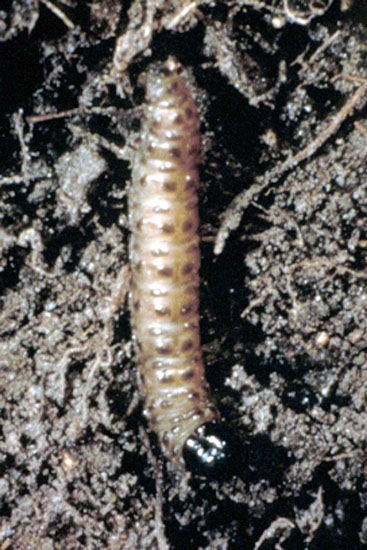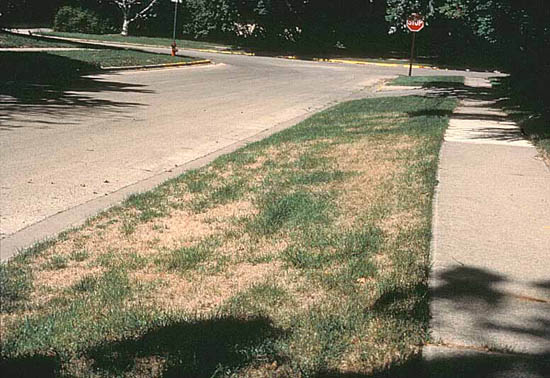Issue 12, July 16, 2012
Sod Webworm
We have been receiving reports of high numbers of sod webworms throughout the state. Sod webworm caterpillars are more common in nonirrigated turf in Illinois during seasons of drought. The larvae are very susceptible to microsporidia disease, particularly under cool, damp conditions.
Several species of sod webworms occur in Illinois. The most common is the larger sod webworm, the species primarily discussed here. Other Illinois species of turfgrass-feeding webworms appear similar but may be slightly different in size and may prefer some turfgrass species to others.
Sod webworms overwinter as larvae in the thatch. Sod webworm larvae are slender caterpillars that are grayish to tan and covered with brown spots. They construct a silk-lined burrow in the thatch, where they hide during the day. At night, they leave their burrow to feed on grass blades. They cut individual grass blades within 1/8 inch of the plant's crown and take many of the blades back to their burrow to eat. Fully grown, 1-inch-long caterpillars pupate in their burrow, emerging later as adult moths.

Sod webworm larva.
The adult moths are tan, about ¾-inch long, with a wingspan of about 1 inch. The palps on the front of the head are elongated, giving the moth the appearance of having a long snout. When at rest, the wings are held tightly against the body so that the body appears tube-shaped; these moths are commonly called tube moths or closed-wing moths. They sit in the turf during the day. When disturbed, the moths rarely fly higher than 5 or 6 feet above the turf and fly in a jerky up-and-down manner before settling back into the turf within 30 feet of where they were disturbed. If a moth is approached slowly and quietly, it can be observed at rest, typically sitting crosswise on a grass blade.

Sod webworm adult on Kentucky bluegrass.
The moths mate, and females drop eggs into the turf as they fly closely above it. Within a couple of weeks, the eggs hatch into larvae. There are usually three generations per year in Illinois. Overwintering larvae emerge as adults from late May to mid-June, with the second generation present as moths from late July to mid-August. The third generation will be present as moths from late August to September or even October, depending on the year. These moths lay eggs that hatch into the overwintering larvae.
Damage appears as scattered brownish areas of turf, with these areas combining into large brown areas later. Close examination reveals firmly rooted turf that appears brown because many of the grass blades are missing and the thatch is exposed. Close inspection of the crowns of the turfgrass plants reveals very short stubs remaining from green grass blades eaten off by the sod webworm larvae. Green, pinhead-sized, fecal pellets will be easily seen at the base of the plants. Damage may occur from spring into fall but is most common in midsummer. Areas of turf that have turned brown due to hot, dry weather should be checked frequently for sod webworms. It is common in Illinois that some of these areas will fail to green up with subsequent rainfall or irrigation due to sod webworm attack.

Sod webworm damage to Kentucky bluegrass.
Scouting for sod webworms can be accomplished through several methods besides observing damage signs. Probably the most common method of scouting is to observe when sod webworm moths are present in large numbers in turf areas. Through turf maintenance such as mowing or fertilization, the moths fly up and are easily recognized by their jerky, short flights. Note heavy numbers on the calendar, and plan to scout for larvae or treat with insecticide about 2 weeks after large numbers of moths are seen. Because the moths in the turf lay eggs that take 2 weeks to hatch, a treatment after egg hatching effectively controls a large population before they cause meaningful damage. If the weather is cool and damp, scouting for larvae is recommended before treatment occurs because insect development may be slow and diseases kill many of the larvae.
Insect-feeding birds, particularly starlings, feed heavily on sod webworm larvae in turf. The presence of starlings and other birds in large numbers on turfgrass areas for several days in midsummer is a clue that they may be feeding on sod webworm larvae. Close examination of the turf reveals holes (poked into the turf by beaks) that are 1 to 2 inches deep and almost ½ inch in diameter. Further turf examination should reveal sod webworm feeding damage or frass.
Although sod webworm larvae are difficult to locate in the thatch, they can be brought to the surface where they can be easily seen and counted. Irritating drenches of 1 teaspoon of 6 percent pyrethrin (or 1 ounce of liquid dishwashing detergent per gallon of water) applied to 1 square foot of turf drives out the sod webworms. Two or more sod webworm caterpillars per square foot are sufficient to cause obvious damage.
Control sod webworms by applying bifenthrin (Onyx, Talstar), carbaryl (Sevin), deltamethrin (DeltaGard), lambda-cyhalothrin (Scimitar), spinosad (Conserve), or trichlorfon (Dylox) to the turf, usually as a liquid, and allowing it to dry on the grass blades to poison the sod webworm larvae when they feed on the grass blades at night. Granular insecticides are effective, but they must be watered lightly to activate them.
Nonchemical control in Illinois occurs naturally almost every year by microsporidian diseases of the sod webworm larvae, particularly during the winter. In addition, birds and predatory insects are effective control agents. The insecticidal nematode, Steinernema carpocapsae (Biosafe), is also effective. Endophyte-containing turfgrasses, such as some fescues and ryegrasses, effectively control sod webworm larvae as well. (Phil Nixon)
Author:
Phil Nixon